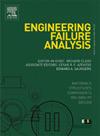硫酸盐暴露和持续高应力条件下frp约束煤矸石混凝土的压缩特性和模型
IF 4.4
2区 工程技术
Q1 ENGINEERING, MECHANICAL
引用次数: 0
摘要
随着纤维增强聚合物(FRP)技术的发展,FRP约束煤矸石混凝土(FCGC)作为一种潜在的地下矿山支护材料已被探索。然而,支撑结构面临着恶劣的条件,包括硫酸盐暴露和持续载荷,这将严重影响FCGC的抗压性能。因此,以内混凝土、FRP层、应力强度比、硫酸盐浓度和荷载持续时间为变量,对硫酸盐暴露和持续高应力条件下的FCGC进行轴压试验。结果表明:与对照试样相比,在硫酸盐暴露和持续高应力条件下,FCGC的破坏模式仍以靠近中高区域的FRP箍断裂为特征,且应力-应变曲线也呈现双线性模式;由于内部混凝土的密实性,初始部分的斜率略有增加,而第二部分则出现退化。残余极限应力应变比分别为0.897 ~ 1.062和0.633 ~ 0.805,且随着硫酸盐浓度和应力强度比的增大,降解程度增大。此外,在硫酸盐暴露和持续高应力条件下,在轴向应变相同的情况下,FCGC的侧向应变变大。在此基础上,结合荷载持续时间、硫酸盐浓度、应力强度比等影响因素对强度和应变模型进行了修正。本文章由计算机程序翻译,如有差异,请以英文原文为准。
Compressive behavior and models of FRP-confined coal gangue concrete after sulfate exposure and sustained high stress conditions
With advancements in fiber-reinforced polymer (FRP), FRP-confined coal gangue concrete (FCGC) has been explored as a potential supporting member for underground mines. Nevertheless, supporting structures face harsh conditions, including sulfate exposure and sustained load, which can severely impact the compressive performance of FCGC. Thus, the axial compressive test was performed on FCGC after sulfate exposure and sustained high stress conditions, taking inner concrete, FRP layer, stress-to-strength ratio, sulfate concentration and load duration time as variables. Results indicate that after sulfate exposure and sustained high stress conditions, the failure modes of FCGC also feature the FRP hoop rupture near the mid-height region, and the stress–strain curves also display a bilinear pattern, compared to the control specimens. The slope of the initial portion shows a slight increase due to the compactness of the inner concrete, while the second portion exhibits a degradation. The residual ratio of ultimate stress and strain ranges from 0.897–1.062, and 0.633–0.805, respectively, where the extent of degradation increases with higher sulfate concentration and stress-to-strength ratios. Besides, after sulfate exposure and sustained high stress conditions, the lateral strain of FCGC becomes larger if the axial strain is the same. Furthermore, the strength and strain models were modified incorporating the impact factors of load duration time, sulfate concentration, and stress-to-strength ratio.
求助全文
通过发布文献求助,成功后即可免费获取论文全文。
去求助
来源期刊

Engineering Failure Analysis
工程技术-材料科学:表征与测试
CiteScore
7.70
自引率
20.00%
发文量
956
审稿时长
47 days
期刊介绍:
Engineering Failure Analysis publishes research papers describing the analysis of engineering failures and related studies.
Papers relating to the structure, properties and behaviour of engineering materials are encouraged, particularly those which also involve the detailed application of materials parameters to problems in engineering structures, components and design. In addition to the area of materials engineering, the interacting fields of mechanical, manufacturing, aeronautical, civil, chemical, corrosion and design engineering are considered relevant. Activity should be directed at analysing engineering failures and carrying out research to help reduce the incidences of failures and to extend the operating horizons of engineering materials.
Emphasis is placed on the mechanical properties of materials and their behaviour when influenced by structure, process and environment. Metallic, polymeric, ceramic and natural materials are all included and the application of these materials to real engineering situations should be emphasised. The use of a case-study based approach is also encouraged.
Engineering Failure Analysis provides essential reference material and critical feedback into the design process thereby contributing to the prevention of engineering failures in the future. All submissions will be subject to peer review from leading experts in the field.
 求助内容:
求助内容: 应助结果提醒方式:
应助结果提醒方式:


